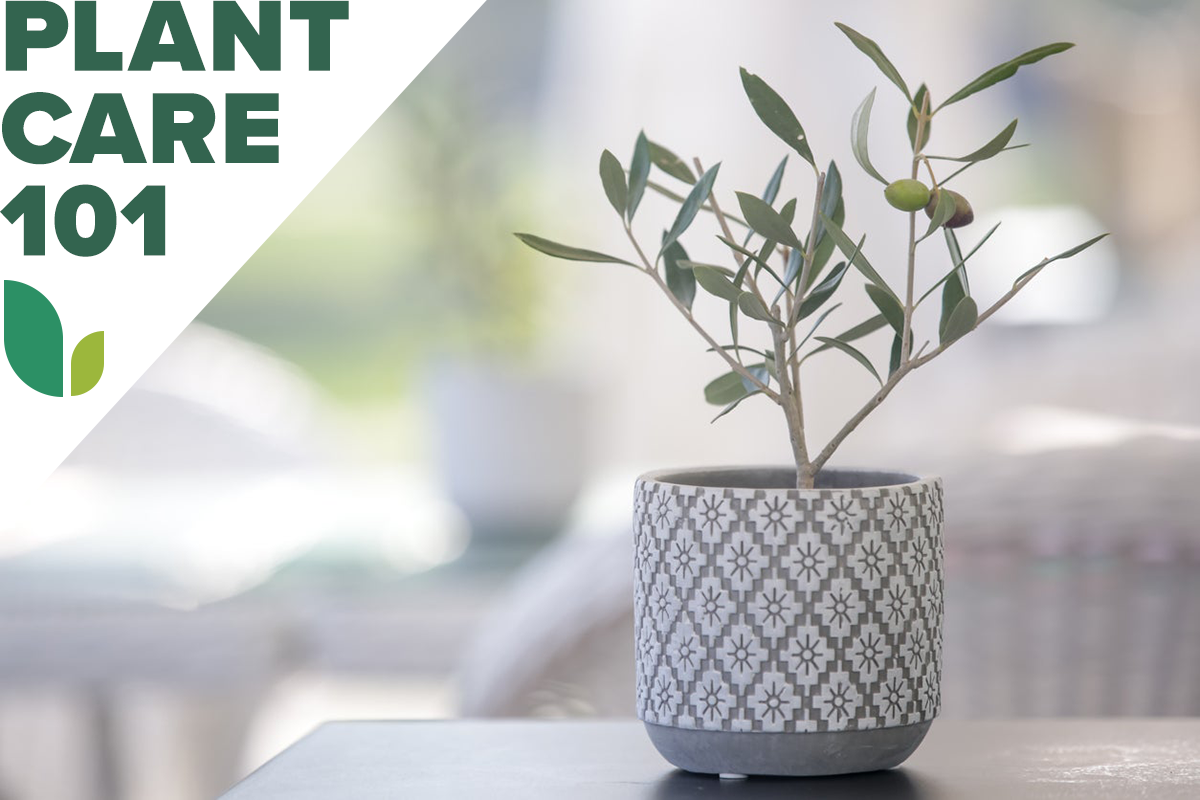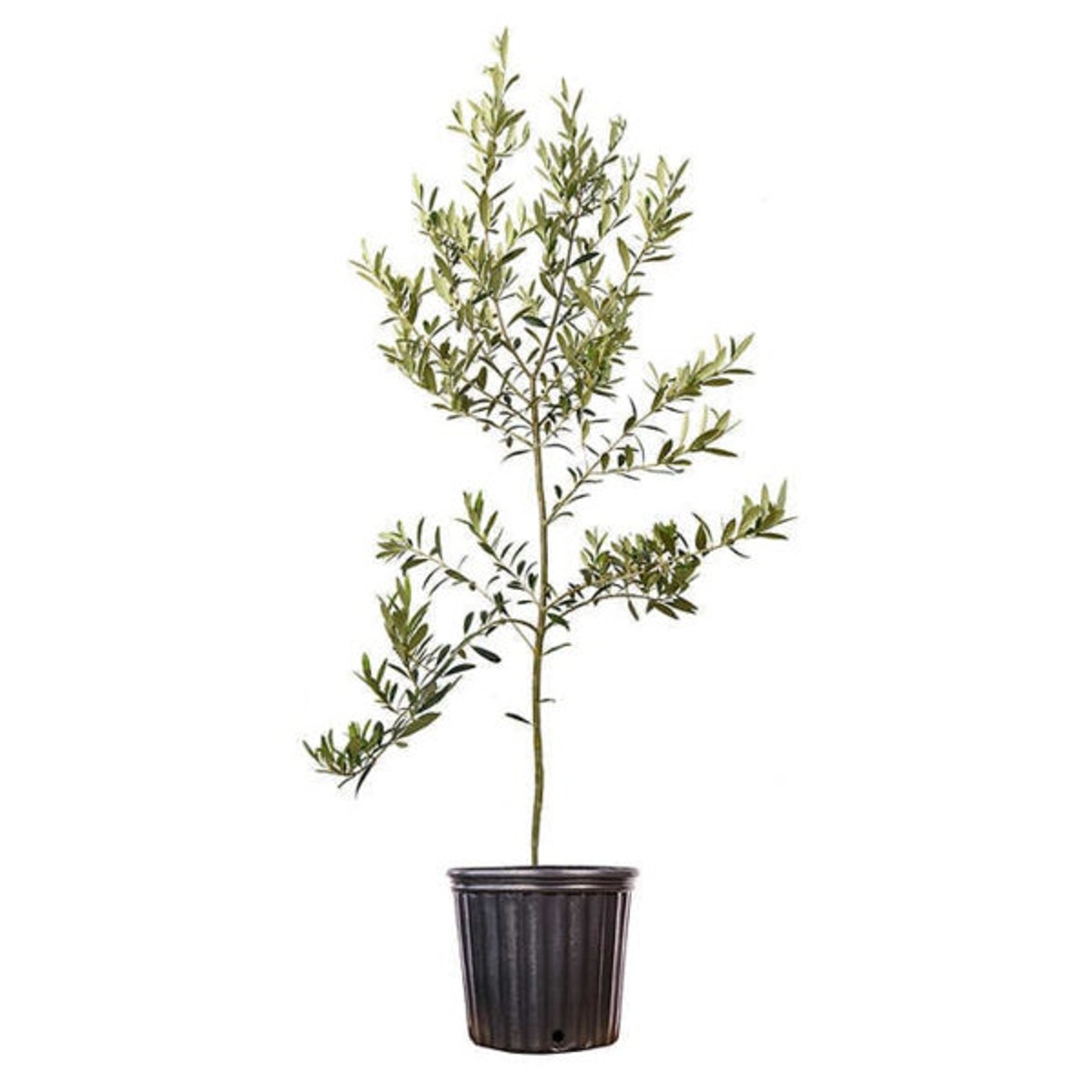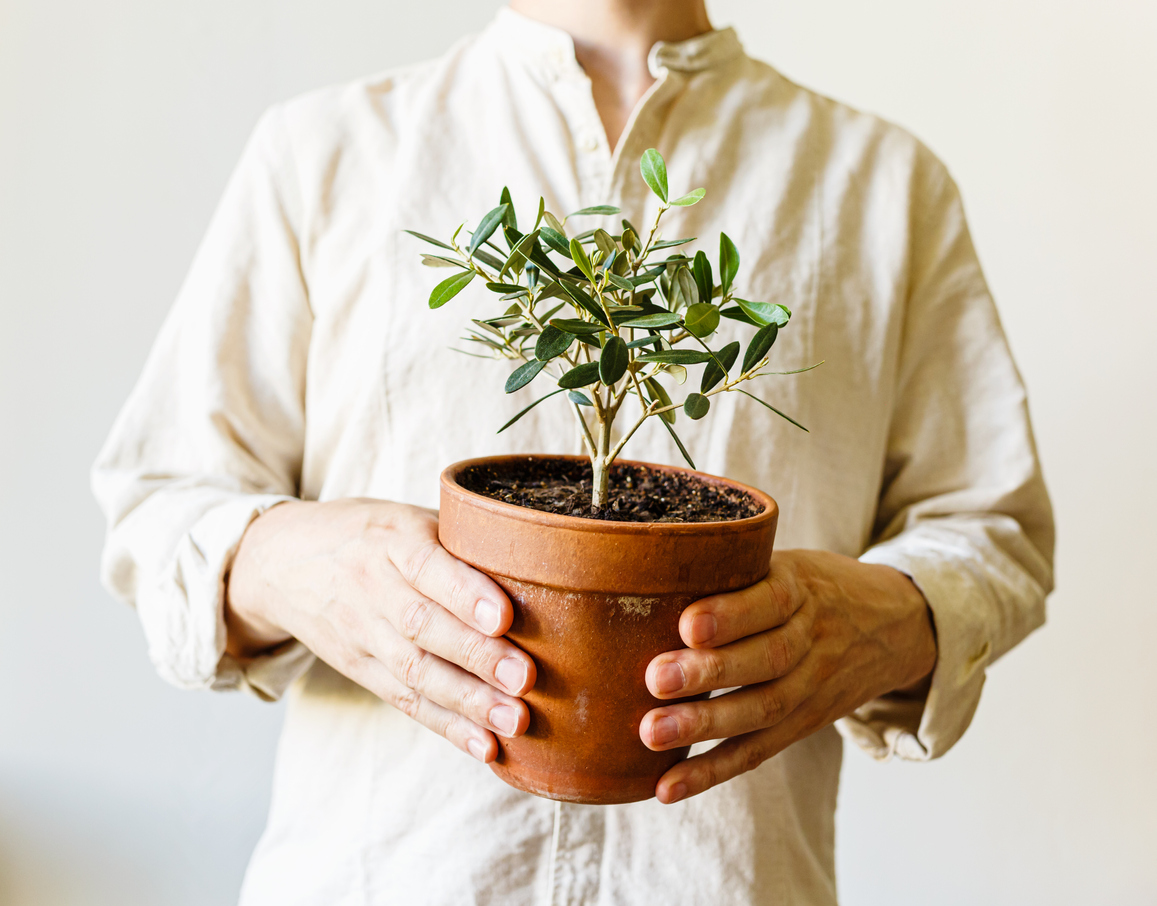

We may earn revenue from the products available on this page and participate in affiliate programs. Learn More ›
Thanks to its Mediterranean heritage, the indoor olive tree tolerates dry air and dry soil, making it easy to care for in interior environments where the air is traditionally dry. Growing an olive tree in a pot isn’t complicated as long as you provide full sun, the right soil, a pot with drainage, water as needed, and seasonal fertilization.
While some people have been keeping artificial olive trees in their homes for years because they like the look of the plant, people today want to keep real olive trees indoors. The real-life version doesn’t require much more maintenance than the faux variety, but it offers so much more. If you don’t know how to grow an olive tree, follow this handy guide for tips.
RELATED: The One Rule of (Green) Thumb When Decorating With Houseplants
Indoor Olive Tree Care at a Glance
Olive tree care indoors is relatively simple. These low-maintenance plants make a beautiful addition to your home’s décor and ask little in return.
Common Name: Olive tree
Scientific Name: Olea europaea
Soil: Sandy, fast-draining; cactus mix
Light: Full sun; bright, direct light
Water: Water thoroughly, let dry between waterings; reduce water in fall and winter
Food: Fertilize every 2 weeks with a balanced liquid fertilizer at half-strength in spring and summer
Temperature and Humidity: Warm temperatures: 65 to 80 degrees Fahrenheit; average humidity: 40 percent
Propagation: By seed or stem cuttings (although stem cuttings don’t root easily)
Safety: No parts are known to be toxic to animals
Olive Tree Characteristics
Olive trees have been cultivated for 6,000 to 8,000 years. Once grown primarily for the fruit they produce, Olea europaea and various hybrids are now grown just as often as a majestic olive tree houseplant.
Available in fruiting, non-fruiting, standard, and dwarf varieties, the indoor olive tree features delicate leaves reminiscent of an oleander, with narrow gray-green foliage that has furry undersides. In summer, they produce delicate clusters of small, creamy white flowers that turn into fruit. Despite the flowers’ delicate appearance, the olive tree is actually a pretty tough plant. In fact, they’re so tough that their root system can regenerate itself even if the above-ground tree is destroyed by frost, fire, or disease.
These slow-growing trees are long-lived plants, with some in the Mediterranean being scientifically verified as 2,000 years old. One Croatian tree has been radiocarbon-dated at 1,600 years old and it still produces abundant fruit. Today, there are 865 million olive trees, each of which can produce 400 pounds or more of fruit annually.
Types of Olive Tree
There are many types of olive trees available.
- Arbequina: Native to Catalonia, it remains small when grown in a container, which makes it a good candidate for growing indoors. It’s a more cold-tolerant variety that produces a small, light brown olive that is firm, mild, and fruity.
- Mission: Originally from Spain, it has been grown in California since the 1700s, thanks to Franciscan missionaries. Also a cold-tolerant type, this plant produces a mild-flavored snacking olive that is either brine-cured while green or oil-cured when black.
- Picholine: The most common olive in France, from where it hails, is used for snacking and cooking because of its spicy, nutty flavor. The tree is a good choice for growing in containers; its size can be managed by pruning.
- Manzanilla: The Spanish olive is the most popular olive in the United States, and is an attractive, slow-growing tree that features billowing branches of bright green olives and a gnarled trunk. It does not like cold weather or drafts.
- Amfissa: A Greek olive that produces purple drupes. Due to its fast-growing nature and spreading growth habit, it doesn’t make a good houseplant.
Selecting Soil for Indoor Olive Trees
Cactus soil is ideal for olive trees, but any sandy or grainy mix that drains easily will work. Olive trees don’t tolerate soggy or slow-draining soil. Mixing in perlite, bark chips, or small gravel can improve drainage and aeration. Along with a fine-textured, non-stratified soil (soil that doesn’t change porosity at different depths within the active root zone), olive trees prefer a soil pH of 5.5 to 8.5.
To assist with drainage, choose a pot with a hole in the bottom. It’s not recommended to use compost or mulch, because they hold more moisture than an olive tree needs.
The Right Light

Unlike many popular low-light houseplants, olive trees need bright, direct light—and plenty of it. They need as much direct sunlight as possible, all year round.
To get enough light indoors, they should be placed in a sunny, south-facing window where they can get at least 6 hours of full sun per day. However, their leaves shouldn’t touch the window or they will “burn.”
Olive trees grown indoors can benefit from grow lights. They will also enjoy spending the summers outside, but must be carefully acclimatized to outdoor light over the course of a week or two or their leaves can “burn” from overexposure. The chances of setting fruit increase if olive trees summer outside.
RELATED: The Best Gardening and Plant Identification Apps for Your Smartphone
Watering Olive Trees
Olive trees don’t like soggy soil, but they can be thirsty during their growing season (spring through fall). During that period, water them thoroughly and leave them to dry out before watering again. Olive trees should be planted with well-draining soil in a pot with a drainage hole in the bottom to allow excess water to run out. If the tree’s roots remain water-logged for long periods of time, it could die.
If the top 2 inches of soil is dry, they’re ready to be watered again. Watering should be reduced during the winter, when the tree is dormant.
Fertilizing Olive Trees
Olive trees benefit from fertilizer with a 16-16-16 nitrogen, phosphorus, potassium ratio to remain healthy and produce. A balanced liquid fertilizer diluted to half strength should be applied every other week in the spring and summer. Alternatively, apply a slow-release fertilizer twice a month, starting in early spring.
Some experts advise not fertilizing between August and March, but in the fall and winter you can use a nitrogen-based, balanced houseplant fertilizer monthly, particularly as olive trees tend to be deficient in nitrogen. Follow the product directions for the proper amount.
It’s not recommended to use compost or mulch on indoor olive plants because they hold more moisture than an olive tree needs.
Setting the Temperature and Humidity

Olive trees prefer the warm Mediterranean climate, where they enjoy hot, dry summers and cool, moist winters. You can recreate these conditions in your home by keeping the temperature between 65 and 80 degrees Fahrenheit.
Since olive trees can tolerate higher heat, and because they love sunshine and circulating air, you can treat them to a summer vacation outside. Just be sure to bring them in before temperatures fall. The minimum temperature they can tolerate safely is 40 degrees Fahrenheit, and they will not survive in temperatures below 15 degrees Fahrenheit. But if you live in Zone 11 or warmer on the USDA Plant Hardiness Zone Map, you can leave them outside year-round. Those in zones 8 through 10 might have success, but will need to protect the trees on the coldest nights.
Average room humidity of around 40 percent is fine for olive trees. They can easily tolerate dry air, and, in fact, misting is not advised specifically because olive trees prefer drier air.
Safety Considerations
Neither the leaves nor the bark—or even the drupe—from the olive tree are toxic to dogs or cats, according to the ASPCA. They are not poisonous at all. However, if a pet consumes an olive pit, it could cause choking or blockage. It’s also hard enough to chip a tooth if chomped on.
Although they don’t contain toxic substances, eating too many olives can cause minor problems for a pet, such as dehydration from the natural salts or loose bowels and stomach upset.
Potential Pests and Diseases
Olive trees have fewer problems with pests than most fruit trees, but they are vulnerable to some. An olive tree indoors is susceptible to scale, a hard-shelled insect identifiable by white waxy eggs it deposits on leaves and stems. By sucking sap, these insects weaken plants. Spraying with insecticidal soap or alcohol can eliminate them.
Spittlebugs can harm olive trees indoors because they carry bacteria (Xylella fastidiosa) that can kill the plants. Entire groves of ancient olive trees in Spain and Italy have been destroyed by this pathogen. Spittlebugs also feed on plant sap. They’re easy to spot because they excrete bubbly foam to create a protective fortress around themselves. Later, they emerge as adult froghoppers, sap-sucking bugs. Remove spittlebugs by hand or with a spray from the hose.
Olive scab, a fungal disease, causes premature leaf drop and can negatively impact the tree’s overall health.
RELATED: 11 Indoor Gardening Projects Absolutely Anyone Can Do
FAQs About Olive Tree Care

While olive trees make great indoor houseplants, a few tips will help an olive tree thrive in that environment. First, it’s wise to select dwarf olive trees, which grow well in containers. Although they flourish in dry air commonly found in indoor environments, the plants still need abundant sunlight, which can be difficult to provide. They’ll benefit from spending the summers outdoors, especially if you’re hoping for flowers or drupes. But don’t get too attached; they can’t live inside forever.
An olive tree indoor plant can live about 8 or 9 years inside.
An olive tree will drop leaves if it’s not getting enough sunlight.
Some olive trees grow year-round outside in USDA zones 8 and warmer, but they don’t do well if the temperature drops below 40 degrees Fahrenheit consistently and can die at temperatures of 15 to 20 degrees Fahrenheit.
Place a potted olive tree close to the house for warmth. Mulch the base and wrap the pot with horticultural fleece. Reduce watering.
The leaves, bark, and fruit of olive trees are safe for dogs, according to the ASPCA.
An olive plant indoors can grow to 10 feet high. A dwarf olive tree can grow to be 6 feet tall.
Looking for more fruiting trees and plants you can grow indoors? Check out our guides on caring for coffee plant, pineapple plant, and avocado plant.
